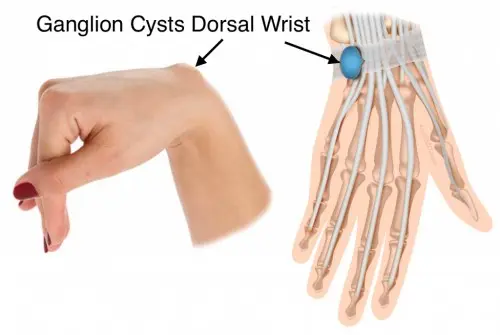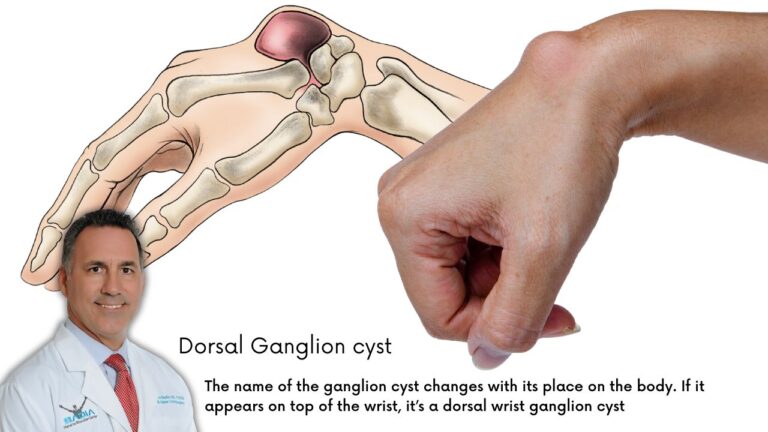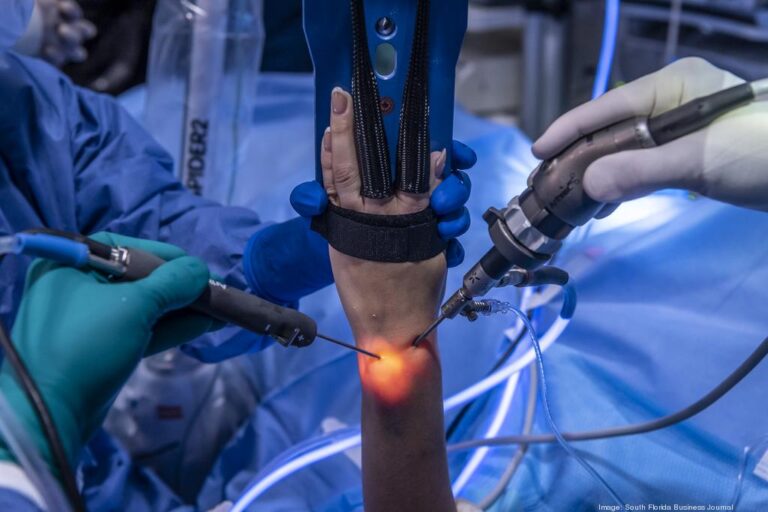A ganglion cyst is a tumor or swelling on top of a joint or the covering of a tendon (tissue that connects muscle to bone). It looks like a sac of liquid (cyst). Inside the cyst is a thick, sticky, clear, colorless, jellylike material.
Depending on the size, cysts may feel firm or spongy. One large cyst or many smaller ones may develop. Multiple small cysts can give the appearance of more than one cyst, but a common stalk within the deeper tissue usually connects them. This type of cyst is not harmful and accounts for about half of all soft tissue tumors of the hand.

They are more common in women, and 70% occur in people between the ages of 20-40. Rarely, ganglion cysts can occur in children younger than 10 years.
Ganglion cysts most commonly occur on the back of the hand (60-70%), at the wrist joint and can also develop on the palm side of the wrist. When found on the back of the wrist, they become more prominent when the wrist is flexed forward. Other sites, although less common, include these:

The cause of ganglion cysts is not known. One theory suggests that trauma causes the tissue of the joint to break down forming small cysts, which then join into a larger, more obvious mass. The most likely theory involves a flaw in the joint capsule or tendon sheath that allows the joint tissue to bulge out.
The ganglion cyst usually appears as a bump (mass) that changes size.
It is usually soft, anywhere from 1-3 cm in diameter (about .4-1.2 inches) and doesn’t move.
The swelling may appear over time or appear suddenly, may get smaller in size, and may even go away, only to come back at another time.
Most ganglion cysts cause some degree of pain, usually following acute or repetitive trauma, but up to 35% are without symptoms, except for appearance.
The pain is usually nonstop, aching, and made worse by joint motion.
When the cyst is connected to a tendon, you may feel a sense of weakness in the affected finger.
A physical exam is often all that is needed to diagnose a ganglion cyst.
Your doctor may get further confirmation by using a syringe to draw out some of the fluid in the cyst (needle aspiration) or ultrasound. Ultrasound is a type of sound x-ray. It can determine whether the bump is fluid-filled (cystic) or if it is solid. Ultrasound can also detect whether there is an artery or blood vessel causing the lump.
Your doctor may send you to a hand surgeon if the bump is solid or involves a blood vessel (artery).
Magnetic resonance imaging (MRI) is used to see the wrist and is very useful for ganglions. One drawback to this diagnostic method is the cost of the procedure.

Arthroscopic ganglion cyst removal is a minimally invasive procedure that effectively eliminates the cyst from its pedicle. It’s essential to note that a significant proportion of cysts (ranging from 38% to 58%) can spontaneously resolve without the need for any treatment.
Over the years, various treatments have been proposed to address ganglion cysts. Some of these approaches include advising individuals with asymptomatic cysts not to be overly concerned, performing needle aspiration to remove the cyst’s contents, or resorting to surgical intervention.
The aspiration procedure typically involves inserting a needle into the cyst, withdrawing the fluid material, administering a steroid compound (with anti-inflammatory properties), and then immobilizing the wrist to prevent movement.
Research studies have indicated that a single needle aspiration can lead to a cure in up to 74% of cases.
With three aspirations, the likelihood of a cure increases to 85%, particularly for cysts located on the back of the hand.
When comparing aspiration/injection to surgical removal, in general, cysts are less likely to recur following surgery.
Surgical cyst removal becomes necessary when the mass is causing pain, interfering with hand function (especially if it’s the dominant hand), or leading to numbness or tingling in the hand or fingers.

Monday- Friday: 8:30AM- 5:00 PM
Saturday- Sunday: Closed